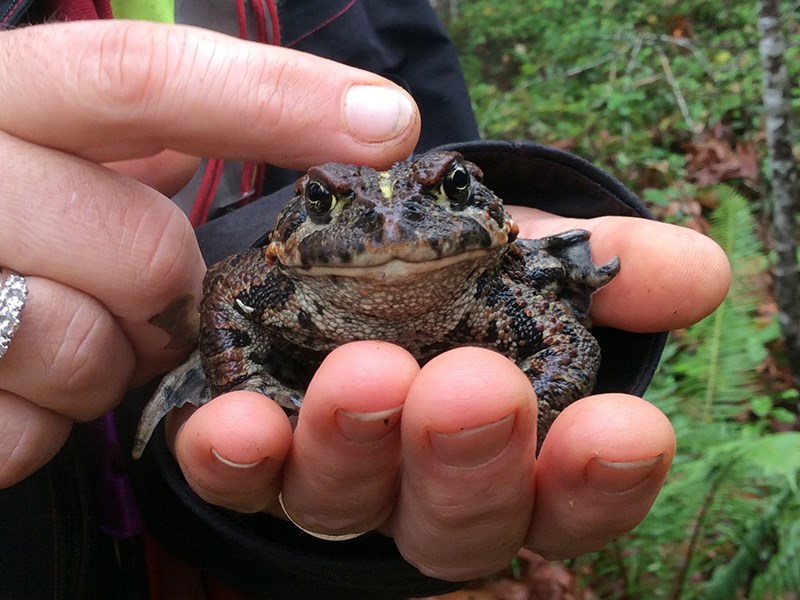Breeding season is upon the western toad. Preparations have been made along Toad Alley at Inland Lake in Powell River’s backcountry to protect more toads and their little toadlets from being squished by bikers and hikers.
Volunteer members from Powell River’s trail building Chain Gang and Powell River ATV Club were recently at Inland Lake completing some work to make life safer for the toads when they move en masse in their unique circle of life.
The toads move in such large numbers that they have been known to close roads. Last August, approximately 1,800 finger-nail sized toadlets were crossing trails near Whistler every hour.
Signs on Toad Alley alert people to be mindful of the toads, but because they are so tiny, at busy times during migration trail users who do not bother to look down end up crushing them.
Enter the Chain Gang and friends to the rescue.
There are three hotspots along the Inland Lake trail where western toad breeding migrations occur.
Last week, the Chain Gang completed work it started last year at the heaviest crossing on Toad Alley, just minutes from the area’s busy provincial park.
“We built some boardwalk last year in time for the migration,” said Chain Gang member Wayne Brewer. “We decided we would like to extend the boardwalk and save more of them. They get squished by the hundreds and thousands because they're so small people don't see them.”
The species, bufo boreas, is on schedule one of the federal Species at Risk Act but not of concern or special status in BC, although population declines are suspected on Vancouver Island, in the Lower Mainland and on the Sunshine Coast.
“We know of very few breeding sites in the area and we think that they've potentially declined in this area,” said amphibian biologist and independent consultant Elke Wind. “A species that can seem so common and healthy and widespread can come down so quickly.”
Unlike the American bullfrog, which is a huge and destructive problem in BC, the western toad is not considered an invasive species.
A single female will produce approximately 12,000 eggs; more than 99 per cent of those will not survive to adulthood.
As breeding season begins, adults start to gather at wetlands and lakes across the Pacific Northwest.
“They'll all breed at one location and they'll all breed at the same time,” said Wind, who lives in Nanaimo. She has been working in the amphibian field since graduate school in the mid-1990s and, in 2009, started studying toads, concerned the little toadlets crossing the road were being killed.
“They're very synchronous in their breeding compared to other species,” said Wind. “So, what happens is you get all the eggs together. The tadpoles hang out all together as they're developing throughout the spring and summer. They swim around in these big schools of black tadpoles and then they all come out to land at the same time.”
Most of the $6,320 in funding for the Toad Alley project came from Powell River Community Forest.
Chain Gang member Ron Diprose said he used to walk around the lake when the toadlets were migrating and there would be thousands of them.
“They would be like a carpet hopping across,” said Diprose, who used to raise the toads, along with 56 amphibians and reptiles in his parent’s basement.
“My mother was very patient,” said Diprose, who joked that he did not have girlfriends in high school; he had toads.
Diprose said he was the biology lab assistant when he attended Brooks Secondary School and was responsible for dissecting the toads he did not rescue.
Western toads live most of the year in the forest, according to Diprose.
“They go down to the lake to mate and then when the tadpoles turn into toadlets they go back into the woods,” he said.
Similar to most male species in the animal kingdom, male western toads do not have any self-restraint when mating, unless it is with another male toad, nor are they the smartest toad in the lake when hormones are raging, according to Wind.
“The male toads all gather together in the same location and when the females come they basically are just swimming around and grabbing anything that looks toad-like in the hopes it's a female,” said Wind. “The only way they know if they have a male or a female is the males are designed to squeak if they get grabbed from behind.”
To remove any doubt, the horny toad is an entirely different species from the western toad.
Wind loves the western toad and finds the derogatory slur of the word “toad” to be insulting.
“I do love them. Of the different species I've worked with, I find them to be more charismatic because they have beautiful eyes and they move very gently and very slowly,” she said. “They're crawlers and they're not worried as much about predators because they have this toxic skin. Their feet are very much like hands, they're very gentle creatures and they're very unique in terms of their life history compared with other amphibians.”



